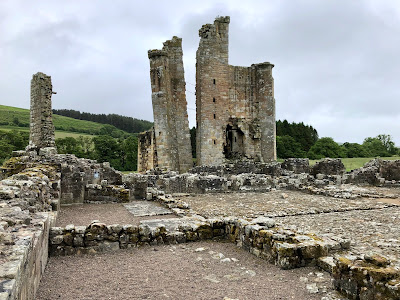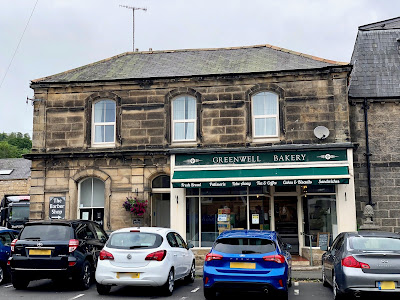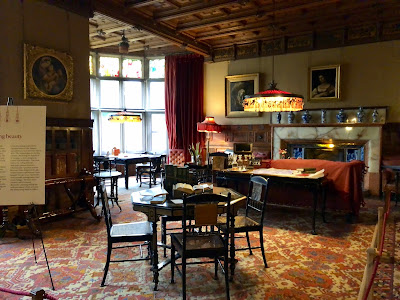Northumberland Day 5 - Edlingham Castle, Rothbury & Cragside
The morning of Day 4 was chilly and misty. That was ok since we had a lot of sunshine for the last two days and have got some sunburn. We had pre-booked tickets to enter Cragside at 10 am. First we stopped by at Edlingham Castle on our way to Cragside. The castle was reached by a short walk from a church, where we parked our car. The pass to the castle was in the cow pasture but fenced so that we would't need to ask cows to give us a way unlike the National Park walk a day before.
Moo, moo!
According to English Heritage, Edlingham Castle was originally a manor house built in the 13th century while the most remains of the castle were from the 14th century. For example, the hall house, the earliest remains were built around 1300 and a solar tower, the best preserved part of the castle, was built between 1340-50.
The walls of the solar tower were tied with wires. Hang in there!
We still had some time to kill till 10 am. We drove to Rothbury, a market town close to Cragside. We found a bakery that was already open, bought a savory pie for J and a lemon muffin for me, found a bench at a small park in the town and enjoyed the treats. Rothbury was a small town with some shops and a few pubs on High Street and a church on Church Street that connects to High Street.
We stood by at the entrance of Cragside about 15 minutes before 10 am. We were the first National Trust member who arrived there on the day! Cragside is a Victorian country estate originally developed by Lord William, who was the 1st Baron Armstrong and an inventor, engineer, scientist and businessman, and Lady Margaret Armstrong, who loved natural sciences such as geology, botany and horticulture. As the result, Cragside has several unique features; for example, the house was the first in the world to be lit by hydroelectricity, using man-made lakes and underground piping. Also, hydraulic machinery supplied water to the house, powered the lifts, and rotated the spit in the kitchen. Which is why Lord Armstoring is sometimes called "The Magician of the North."
Although the formal garden was't impressive...
Impressive Scots pine trees! One of them is the UK's tallest Scots pine at 131ft (40m).
The house sat on a sandstone crag, looking over the Debdon Burn. I liked hopping up on the long rock steps to the house.
The house was a showcase of Armstrong's rich life and the family's massive collection of contemporary British art, furniture, ceramics and natural history. The inside self-tour started with a kitchen on the ground floor.
Dining Room.
Library.
Japanese Room! The room was dedicated in the 20th century by the 3rd Baron Armstrong of Bamburgh and Cragside to store gifts from East Asian guests to Cragside, particularly, the Japanese elite. Interesting!
The tiles and stained glasses at the corridor and staircase were charming.
Gallery on the first floor.
Drawing Room! The centerpiece of the room was the 6 meter high and 10 tonne colossal marble fireplace that consists of a deep inglenook. We have never seen a walk-in fireplace like that.
When I saw a photo on the table, I thought he looked familiar... Of course, our Former Emperor of Japan who recently reigned as the 125th emperor! The photo was from when he was young and the Crown Prince. In 1953, he visited England to attend the coronation of Elizabeth Ⅱ as the proxy of the Emperor Showa in 1953 and stayed at Cragside for a week. Apparently he gifted the signed photo to the Armstrongs at that time.
After the house tour, we explored a part of the extensive woodland. It would need more than a day to cover the entire woodland. Rhododendrons were blooming everywhere. The pink-purple color brightened the hiking trails cheerfully.
After a good uphill walk, we got to Nelly's Moss Lakes.
We wondered in the Wizard-guarded rhododendron labyrinth for a while, looking for animal silhouettes. When flying bugs started bothering me too much, we escaped from the labyrinth although we have't found all silhouettes yet.
We walked back to the house. As seen from above, the house structure looked pretty complex.
Cragside was very enhancing. It could be the best place we visited during the trip. We went back to Alnwick to have a late lunch/early dinner.
We tried Lilburns, a family run bar-bistro serving a British dishes made with locally-sourced produce. I had asparagus and mushroom risotto. It was pretty good. J had Northumberland sausage that was served on leek and potato mash with gravy. The sausage was so long! He said it was tasty.
We didn't have any desserts at Lilburns. Instead we visited The Cheese Room, a cheesemonger that was located right next to Lilburns, and bought a slice of Victorian sponge cake and a slice of carrot cake. We also picked up a multigrain bread loaf and a local cheese for the next day's breakfast.
Both cakes were lovely!
To be continued...











































